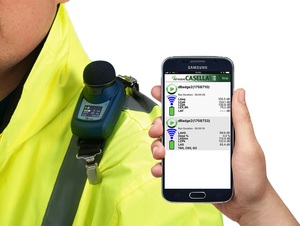
 |
Mark Sennett
Managing Editor |
 |
Kelly Rose
Editor |
| Home> | Managing Health & Safety | >Noise Monitoring | >Make sound choices |
Make sound choices
24 February 2025
Tim Turney explains the dangers of excessive noise exposure and the benefits of implementing a noise monitoring programme.

NOISE CAN be a nuisance for anyone. In industry, excessive and constant noise can pose a significant risk to those exposed. According to the latest statistics by the Health and Safety Executive (HSE), there are an estimated 12,000 workers in the UK suffering from work-related hearing problems1. This number is likely to be underestimated due to the reporting criteria and the limited information about work-related noise induced hearing loss available. Noise induced hearing loss (NIHL) is also irreparable, there is no cure. This is why, when it comes to protecting workers hearing, the best philosophy is one of prevention, not cure.
Those with affected hearing are up to five times more likely to develop dementia, suffer from social isolation, have weakened processing abilities and are at a higher risk of physical injury due to a lack of awareness of immediate hazards.2
The UK enforces good employer practice through the Control of Noise at Work Regulations, which state that employers need to take action to reduce noise exposure, provide noise control measures as well as personal hearing protection for any residual risk. Manufacturers must also continue to make considerations when designing tools and machinery to operate more quietly. Employees must have personal hearing protection made available to them at one action level and must wear hearing protection at the next hearing level. This assumes that the correct hearing protection wear is effectively fitted, worn at all times and maintained in good condition.
Sound is quantified in decibels (dB), utilising a logarithmic scale where each three-decibel rise signifies a doubling of sound energy. This escalation in noise energy corresponds directly to a doubling of the risk of hearing impairment, highlighting the substantial impact even minor increments in decibels can have on employee wellbeing.
In the UK, employers must provide hearing protection when there is an expectation that employees will be exposed to noise exposure levels of 85db(A) averaged across a day or a week.
Hierarchy of controls
The hierarchy of controls should always be used with hearing protection being the last resort, or a first aid measure until noise can be controlled at source. They are listed from the most to least effective and include elimination, substitution, engineering controls, administrative controls and personal protective equipment (PPE).
Noise surveys and monitoring
For noise control, a survey should be conducted to identify the source and determine its contribution to the area noise level and worker noise exposure, so that businesses can identify at-risk employees and ensure they adhere to HSE regulations. However, professionals undertaking the monitoring must be trained and prepared with the right equipment as errors in noise level measurements can lead to errors in exposure calculations. This results in greater risks for employers and employees long term ear health.
The HSE requires employers to conduct health surveillance for anyone expected to be exposed to unsafe levels of noise. Ideally, this will first be conducted when a person joins the business to achieve a baseline reading. Then, it is recommended that audiometric health checks are conducted annually for the first two years and on a three-year basis thereafter.
These programs require employers to evaluate noise levels regularly, offer hearing protection that has been determined as adequate for the noise in the workplace and train employees on their use. This is unless control measures such as to equipment or working schedules are made so that they are less noisy and worker exposure reduced to below action levels.
Noise assessors should ideally use both a sound level meter, primarily designed as a hand-held device used by an operator, and a noise dosimeter, which a staff member wears for their working shift. This ensures primary noise sources can be identified and when exposure is occurring to establish a noise control program.
Hearing protection
When selecting the right makes and models, the attenuation level is critical and noise levels at the ear must be reduced so that exposure is reduced at the ear to an acceptable level. Despite the irreversible nature of NIHL, over half of noise-exposed workers report not wearing hearing protection. It is also important to not provide too much attenuation with hearing protection, which can leave employees feeling isolated and could give a safety risk by not being able to hear vehicles or alarms.
Employers can take a proactive approach to encourage all-day wear by considering comfort, communication, the environment, the individual, and the relationship with other personal protective equipment (PPE).
Removing PPE, even for short periods, has a significant effect on exposure. Therefore, it is crucial that hearing protection is comfortable to increase worker acceptance and support the likelihood of all-day wear. When working in an environment with airborne hazards present, for example, ensuring the hearing protection that has been provided is comfortable and unobtrusive to the respiratory protection worn.
The interaction of hearing protection with other PPE is also a significant factor. For example, an employee wearing prescription or safety glasses may not obtain an adequate fit from a standard earmuff, so plugs or semi-inserts may be more suitable.
Keeping safety in safe hands
The world is getting louder, employers must act now to implement a successful and effective noise control regime.3 However, skill and knowledge of measuring noise can take years to build, so this guidance is a starting point. If certain aspects of noise monitoring, protection and control are outside of an individual’s competencies then external consultancies, training and support should be sought to bridge knowledge gaps and ensure employees get the critical protection they need. When it comes to a permanent health issue like hearing loss, it’s never worth the risk.
Casella is dedicated to reducing occupational health and environmental risks and supporting businesses in solving their monitoring and analysis needs.
Tim Turney is global marketing manager at global monitoring equipment manufacturer Casella. For more information, visit https://www.casellasolutions.com/us/en.html.
References
1 https://www.hse.gov.uk/statistics/causdis/deafness/index.htm
2 https://tinyurl.com/4u7yu3ua
3 https://tinyurl.com/545pwrr7
- Zero air generator
- Accoustic approval
- Efficient & cost-effective
- The Casella Noise Course will return on September 19th
- You can't manage what you don't measure
- Casella launches Guardian2 – the solution for multi-agent site monitoring
- A new director
- Casella launches Guardian2 – the solution for multi-agent site monitoring
- Enhanced sound level meter
- New human vibration meter

























